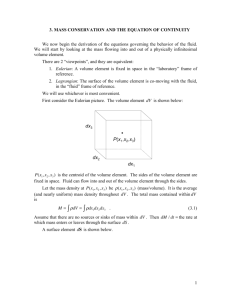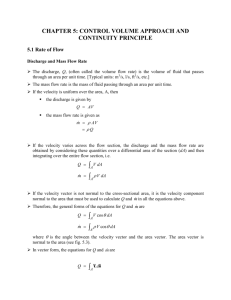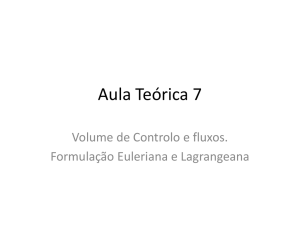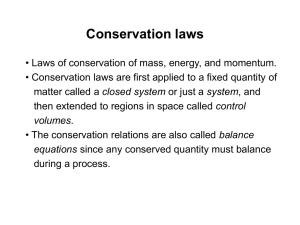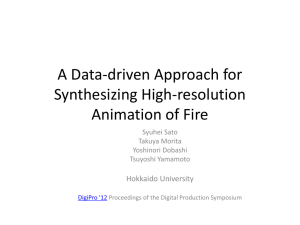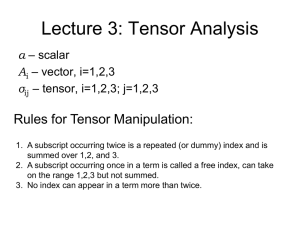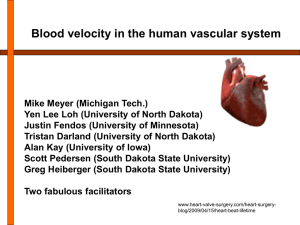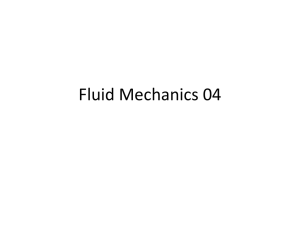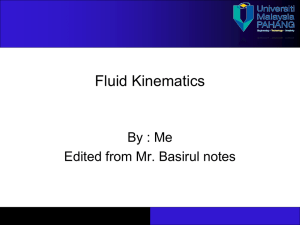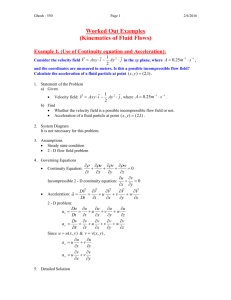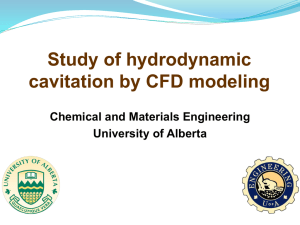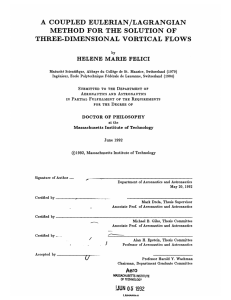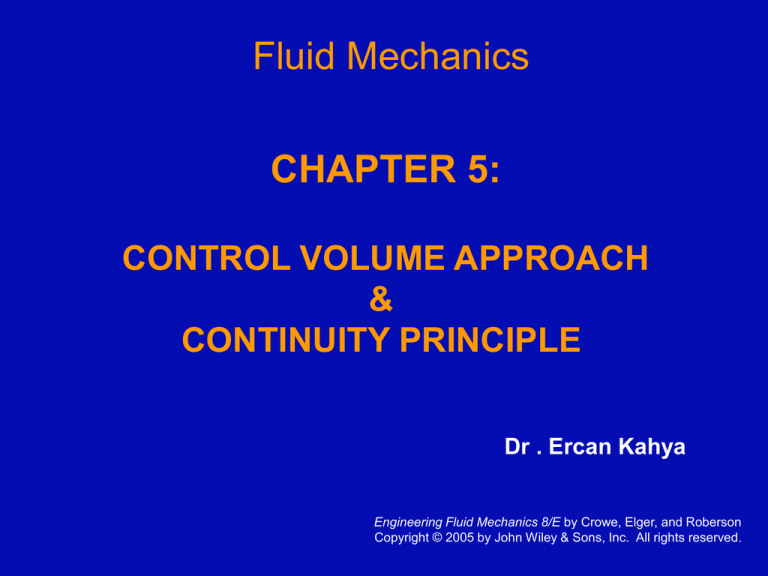
Fluid Mechanics
CHAPTER 5:
CONTROL VOLUME APPROACH
&
CONTINUITY PRINCIPLE
Dr . Ercan Kahya
Engineering Fluid Mechanics 8/E by Crowe, Elger, and Roberson
Copyright © 2005 by John Wiley & Sons, Inc. All rights reserved.
LAGRANGIAN & EULERIAN DESCRIPTIONS
Lagrangian Approach:
Describe the fluid particle’s motion with time.
The path of a particle:
r(t) = x(t) i + y(t) j + z(t) k
i, j, k: unit vectors
Velocity of a particle :
V(t) = dr(t) / dt = u i + v j + w k
Eulerian Approach:
Imagine an array of windows in the flow field: Have information for the
fluid particles passing each window for all time.
In this case, the velocity is function of the window position (x, y, z) and time.
u = f1 (x, y, z, t)
v = f 2 (x, y, z, t)
w = f 3 (x, y, z, t)
Eulerian approach is generally favored
CONTROL VOLUME APPROACH:
“Focusing on a volume in space & Considering the flow passing through
the volume”
* It derives from the Eulerian description of fluid motion.
* It involves transforming the governing equations for a given
mass (Lagrangian form) into the corresponding equations for
mass passing through a volume in space (Eulerian form)
• Mathematical equation needed for this transformation:
REYNOLDS TRANSPORT THEOREM
RATE OF FLOW
• Volumetric Flow Rate:
∆Volume in the figure:
= Length x Area = (V ∆t) x A
Q AV
Q = discharge [m3/s]
V = average velocity [m/s]
A = cross sectional area [m2
• Mass Flow Rate:
Mass of fluid passing a station per unit time [kg/s]
m mass flow rate m/t
ρ = density [kg/m3]
m AV Q
RATE OF FLOW: Generalized equation forms
Volumetric Flow Rate
Differential discharge:
dQ Vn dA
Using concept of dot product:
Vn dA V cosdA V .dA
Mass Flow Rate
Q V .dA
A
m V .dA
A
Mean Velocity
By definition:
_
Q
V
A
• In laminar flow, the mean velocity
is half the centerline velocity.
• In turbulent flow, velocity
profile is nearly flat so the mean
velocity is close to centerline
velocity.
REAL VELOCITY PROFILE:
• Parabolic for laminar flow
• Logarithmic for turbulent flow
Control Volume Approach
• FLUID SYSTEM: Continuous mass of fluid, containing always the same fluid
particles
– The mass of a system is constant
• CONTROL VOLUME (cv): Volume in space.
– It can deform with time
– It can move & rotate
– The mass of control volume can change with time
• CONTROL SURFACE (cs):
• Surface enclosing the control volume
• or boundary of control volume
Control Volume Approach
M sys (t ) M CV (t ) M in
M sys (t t ) M CV (t t ) M out
By definition, the mass of the system is constant, so
M CV (t ) M in M CV (t t ) M out
The rate form of Continuity Principle:
M CV M in M out
dM cv
min mout
dt
Example
• Considering a CV as shown in the earlier figure, a tank with crosssectional area of 10 m2 has an inflow of 7kg/s and an outflow of 5
kg/s. Find the rate at which the water level in the tank is changing.
The volume of CV: V = Ah
The mass in the CV: M cv = V = Ah
The rate of change of mass in the CV:
dM cv
dh
A
dt
dt
By the continuity equation, the rate of change of water elevation:
dh min mout
dt
A
= (7 - 5 ) / (1000 x10) = 0.0002 m/s
B (extensive property) of a system: proportional to the mass of the system (like m, mV, E)
b (intensive property) : independent of system mass and obtained by [B/mass]
Reynolds Transport Theorem
The most general form: (Read excellent explanations at pages 133-138)
dBsys
dt
b
b
B: extensive property
b: intensive property
t: time
ρ: density
V: volume
V: velocity vector
A: area vector
Left side is Lagrangian form & represents the rate of change of property B of
the system
Right side is Eulerian form & represents the rate change of property B in CV + the
net outflow of property B through the CS
This equation is often called “control volume equation”
Reynolds Transport Theorem: Simplified form
If the mass crossing the control surface occurs through a number of inlet and
outlet ports, and the velocity density and intensive property b are uniformly
distributed (constant) across each port; then
dBsys
dt
bdV bV. A
cv
cs
Please see the text book for the alternative form of the above equation
Continuity Equation
Derives from the conservation of mass which states the mass of the
system is constant in Lagrangian form. (M sys = const)
The Eulerian form is derived by applying Reynolds transport theorem.
In this case, extensive property: B cv = M sys
The corresponding intensive property: b = M sys / M sys = 1
Continuity Equation
Since dM sys / dt = 0
The general form of continuity equation:
=0
Accumulation rate Net outflow rate
of mass in CV
+ of mass through CS
If the mass crosses the control surface through a number of
inlet and exit ports, the continuity equation simplifies to
dM cv
cs min cs mout
dt
EXAMPLE 5.4:
Since there is only one inlet and exit port,
the continuity equation simplifies to
dM cv
min mout
dt
Mass flow rate in : ρ V A = 1000 x 7 x 0.0025 = 17.5 kg/s
Mass flow rate out: ρ Q = 1000 x 0.003 = 3 kg/s
Continuity equation:
dM cv
17.5 3 14.5kg / s
dt
Mass is accumulating in the tank at this rate!
EXAMPLE: (Problem 5.49)
Referring the figure below, find the velocity of the liquid through
the inlet. At a certain time, the surface level in the tank is 1 m and
rising at the rate of 0.1 cm/s.
Solution
Continuity Equation for Flow in a Pipe
Steady Flow
- CV is fixed to pipe walls
- Volume of CV is const.
- Mcv = const.
min mout
22 A22V22 11 A11V11
Continuity Equation
Q2 Q1
A2V2 A1V1
Incompressible flow
valid for steady & unsteady
incompressible flow
Cavitation
Phenomenon that occurs when the fluid pressure is reduced to the local vapor
pressure and boiling occurs.
Vapor bubbles form in the liquid, grow and collapse; producing shock wave, noise &
dynamic effects.
RESULT: lessened performance & equipment failure !
Cavitation typically occurs at locations where the velocity is high.
In case b, flow rate is higher
Cavitation damage examples
Impeller of a centrifugal pump
Spillway tunnel in a power dam
Class Exercises: (Problem 5.44)

